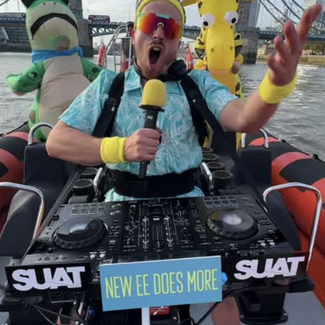
Anatomy of a Transformation
The Future Isn't Just TV: Why Launching New EE Meant A New Approach To Media
Tom Kislingbury, the VP of strategy at EE's media partner EssenceMediacomX, on why EE's relaunch demanded truly addressable media planning
26 February 2024
The connectivity world has changed. People want to be able to access information whenever they want and reach anyone else wherever they may be. They want simplicity.
To meet these needs, brands need to be ambitious in their offerings. It’s no longer about, say, offering a great mobile network. It’s about bringing mobile together with broadband, gaming, smart-home tech, and post-lockdown flexible working.
Advertisers need to be equally ambitious when promoting these brands. Finding that balance between enticing enterprise, and straightforward simplicity involves knowing your audience. Relevance is key, as a ‘one-size-fits-all’ approach won’t work in an ever-evolving landscape of changing requirements.
Therefore, brands can’t rely on what they’ve taken as given in the past. The future shouldn’t be led by just TV advertising. The new comms economy is creator-led, informed by audience insights, and reinforced through brand partnerships.
Brands need to be brave and embrace new opportunities to speak to their audiences in completely different ways, breaking through the stagnated stalemate of traditional media.
Big Brand Launches: simply sticking to the old ways doesn’t work
Big Brand Launches and Relaunches are traditionally built around Big Media. Those TV kick-off spots, the special-build outdoor sites, the homepage takeovers, the high-profile “stunts”.
However, we know that media consumption is increasingly fragmented in the UK. The days when one channel or activation could reach almost everyone are gone. Lead channels are a thing of the past, and the old “fewer, bigger, better” mantra leads to larger and larger blind spots of existing and potential customers who will not be exposed to a campaign - at least not in a way that will create impact or change.
We live in a world where people are getting better and better at avoiding and ignoring ads. We know that if we try to tell a brand story using the established shapes and assumptions of media planning, we’ll be in trouble.
Essentially, you can’t tell a story about a brand answering the behavioural changes of today with the media plans of yesterday.
EE: the challenge of communicating connectivity
EE has been a fabulous brand since it launched back in 2012. In that short time, EE took two separate mobile networks and combined them into a new brand which performed spectacularly well in marketing and business terms. As a result, it’s been the UK’s top mobile network for ten years straight.
In response to the growing need for connectivity and simplicity, EE has relaunched, building its offerings around four crucial areas instead of products: Work, Home, Game, and Learn.
These ‘needstates’ are ways for EE to understand what is going on in people’s lives, and show how it can help. The products are secondary to how people want the brand to simplify their complex lives.
But that’s a complicated story to tell in paid media, especially in an avoidant media landscape.
Refreshing the brand with multiple impact media
From a media planning perspective, needstates are not audiences. People can easily be in several or all of them at once, and move in and out of them over a short period.
Instead, our focus was matching behavioural, emotional and attitudinal factors to buyable media triggers, to create truly addressable media planning.
Our approach to the New EE radically shifted as a result. Instead of starting with big-reach buys in a broadcast-first model, we started with data and relevance in an addressable-first model.
For this and future campaigns, we have prioritised our needstates. Who are the people who need help with flexible Work issues? Who is looking to upgrade their Game capability? Who is dedicated to making sure their kids have the best opportunities to Learn?
By definition, there are many activations and targeting strategies on a campaign like this, but special attention was drawn to matching first-party data to video buying, connecting second-party needstate data to digital audio mood/environment, and bridging the paid/earned divide on social channels to cut through against disparate audiences.
The campaign featured top and tail 60-second TV ads running multiple needstate creative: innovative cinema where we showed all the facets of the new EE, intricate data-fuelled targeting across display, social, video, and digital audio platforms to ensure multiple exposure, a huge launch weekend of standout social takeovers and much, much more.
As you can see, that doesn’t mean there wasn’t a role for big, punchy launch media. We needed to land the fact that New EE comprises multiple solutions across multiple needstates. But instead of solely relying on this approach, we created opportunities for standout, impact media with multiple assets nearby.
This is just the beginning of New EE. The bold move into addressable-first planning at a national scale is paying dividends, and the new version of the brand is set to have the same impact that the original one did. We don’t view this campaign as over or complete.
We’re now into our launch year as opposed to just a launch campaign, and it will see our data-fuelled, addressable-first plans snowball with ever-greater efficiency, effectiveness and innovation.




